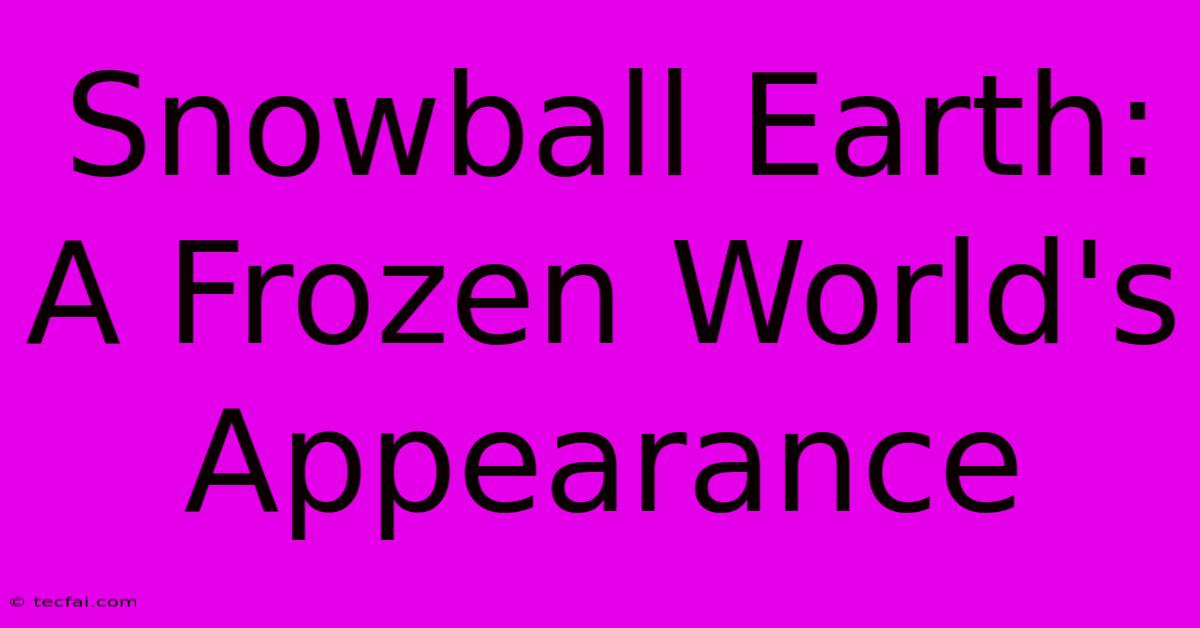Snowball Earth: A Frozen World's Appearance

Discover more detailed and exciting information on our website. Click the link below to start your adventure: Visit Best Website tecfai.com. Don't miss out!
Table of Contents
Snowball Earth: A Frozen World's Appearance
The Earth we know and love, teeming with life and vibrant landscapes, has not always been this way. Billions of years ago, our planet was a completely different place, shrouded in a thick layer of ice. This period, known as "Snowball Earth," is a fascinating and perplexing chapter in Earth's history, captivating scientists and the public alike.
A World Encased in Ice
Imagine a planet where glaciers extend from pole to pole, engulfing continents and oceans in a thick, icy blanket. This is the stark reality of Snowball Earth, a period spanning from 720 to 635 million years ago. During this time, the Earth's surface, from the equator to the poles, was almost entirely covered in ice. This dramatic shift in climate is one of the most dramatic events in Earth's history.
How Did It Happen?
The exact cause of Snowball Earth is still a topic of debate among scientists, but several theories attempt to explain this dramatic change.
1. The Faint Young Sun Paradox:
Early in its life, the sun was much fainter than it is today. This suggests that the Earth should have been completely frozen. However, evidence indicates that this wasn't the case. This paradox leads scientists to believe that greenhouse gases like carbon dioxide and methane were present in higher concentrations, trapping heat and preventing the Earth from freezing.
2. Continental Drift and Plate Tectonics:
The movement of Earth's tectonic plates has a significant impact on climate. During the Snowball Earth period, supercontinents likely formed, with vast landmasses concentrated at the equator. This could have reduced the amount of sunlight absorbed by the oceans, leading to global cooling.
3. Volcanic Eruptions:
Volcanic eruptions, while releasing greenhouse gases, can also release sulfur dioxide, which reflects sunlight back into space. A series of massive eruptions could have triggered a cooling effect, leading to a runaway snowball effect.
The Great Thaw
The transition from Snowball Earth to a more habitable planet was just as dramatic as the freezing process. Scientists theorize that volcanic activity eventually released enough greenhouse gases into the atmosphere, causing temperatures to rise. This led to the melting of glaciers and the return of liquid water to the Earth's surface.
The Impact of Snowball Earth
The Snowball Earth period had a significant impact on the evolution of life on Earth. The extreme cold and lack of sunlight would have made it difficult for organisms to survive. However, this period also might have played a role in the diversification of life. The rapid melting of the ice could have released nutrients into the oceans, providing a boost to early life forms.
Evidence of Snowball Earth
While we can't directly observe Snowball Earth, geological evidence provides compelling support for its existence.
1. Glacial Deposits:
Glacial deposits found in rocks dating back to this period suggest that ice sheets once covered large areas of the Earth's surface.
2. Cap Carbonate Deposits:
Cap carbonate rocks, which are found on top of glacial deposits, are another key piece of evidence. These rocks are rich in carbonate minerals, which would have been deposited in warm, shallow oceans after the ice sheets melted.
A Frozen Past, A Living Present
The story of Snowball Earth reminds us that our planet is dynamic and constantly changing. Studying this period allows us to gain a deeper understanding of Earth's history and the forces that shape our planet. It also helps us to appreciate the delicate balance of Earth's climate system and the importance of protecting it for future generations.

Thank you for visiting our website wich cover about Snowball Earth: A Frozen World's Appearance. We hope the information provided has been useful to you. Feel free to contact us if you have any questions or need further assistance. See you next time and dont miss to bookmark.
Featured Posts
-
From Stars To Style Trevor Sorbies Journey
Nov 14, 2024
-
Bridget Jones Latest Trailer Shows Big Changes
Nov 14, 2024
-
Pete Hegseth Veteran Firebrand Now
Nov 14, 2024
-
India Vs Opponent Ramandeep Singhs Debut
Nov 14, 2024
-
British Stage Star Timothy West Dead At 85
Nov 14, 2024
